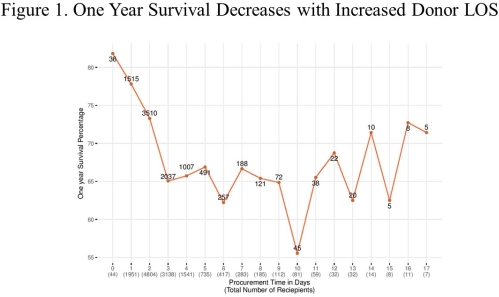Increased Length of Stay of the Donor Decreases Heart Transplant Recipient Survival
H. Copeland,1 R. Talluri,2 A. Panos,1 R. Cochran,1 L. Creswell,1 D. Baran.3
1Surgery, University of Mississippi Medical Center, Jackson, MS
2Biostatistics, University of Mississippi Medical Center, Jackson, MS
3Cardiology, Sentara Heart Hospital, Norfolk, VA.
Meeting: 2018 American Transplant Congress
Abstract number: B41
Keywords: Age factors, Donors, Length of stay, Survival, unrelated
Session Information
Session Name: Poster Session B: Heart and VADs: All Topics
Session Type: Poster Session
Date: Sunday, June 3, 2018
Session Time: 6:00pm-7:00pm
 Presentation Time: 6:00pm-7:00pm
Presentation Time: 6:00pm-7:00pm
Location: Hall 4EF
Purpose: We hypothesize that the longer the cardiac donor is in the hospital prior to procurement, the worse the heart transplant (tx) recipient outcome for survival.
Methods: The United Network for Organ Sharing (UNOS) database was retrospectively reviewed from May 1, 2007 through March 21, 2014 for donor hearts. The date of referral for donation to the time of recovery of the organs was calculated and was defined as the length of stay (LOS) in the hospital. Donor characteristics were evaluated, and recipient survival was evaluated in relationship to the LOS.
Results: 13481 donor hearts were identified. The mean LOS of the donor was 4.37 days (median 3.00; range 0-4384 days). For each extra day the donor stays in the hospital before procurement, the odds of the recipient dying within one-year increases by 6.6%. 3903 (28.95%) donors were female; the mean age of the donors was 31.68 years(y) (9 – 66 y). In the study, there were 1978 (14.67%) cases of female donors donating to male recipients. The most common cause of death was head trauma (55.83%). Multivariate Cox regression analysis demonstrated that increased donor age (Hazard Ratio = 1.012, p<0.001) and increased ischemic time were significantly (Hazard Ratio R = 1.159, p<0.001) associated with increased hazard for mortality of recipients. Figure 1 demonstrates that as the LOS approaches 10 days, the 1 year of the heart transplant survival of the recipient decreases. The trend reverses slightly after 10 days.
Conclusion: As the length of stay of the donor increases, the mortality for the heart transplant recipient increases. This may be due to increased risk to infections, and, hemodynamic instability.
CITATION INFORMATION: Copeland H., Talluri R., Panos A., Cochran R., Creswell L., Baran D. Increased Length of Stay of the Donor Decreases Heart Transplant Recipient Survival Am J Transplant. 2017;17 (suppl 3).
To cite this abstract in AMA style:
Copeland H, Talluri R, Panos A, Cochran R, Creswell L, Baran D. Increased Length of Stay of the Donor Decreases Heart Transplant Recipient Survival [abstract]. https://atcmeetingabstracts.com/abstract/increased-length-of-stay-of-the-donor-decreases-heart-transplant-recipient-survival/. Accessed December 14, 2025.« Back to 2018 American Transplant Congress
